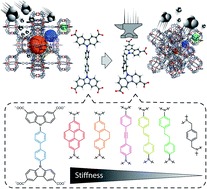Engineering micromechanics of soft porous crystals for negative gas adsorption†
Abstract
Framework materials at the molecular level, such as metal–organic frameworks (MOF), were recently found to exhibit exotic and counterintuitive micromechanical properties. Stimulated by host–guest interactions, these so-called soft porous crystals can display counterintuitive adsorption phenomena such as negative gas adsorption (NGA). NGA materials are bistable frameworks where the occurrence of a metastable overloaded state leads to pressure amplification upon a sudden framework contraction. How can we control activation barriers and energetics via functionalization of the molecular building blocks that dictate the frameworks' mechanical response? In this work we tune the elastic and inelastic properties of building blocks at the molecular level and analyze the mechanical response of the resulting frameworks. From a set of 11 frameworks, we demonstrate that widening of the backbone increases stiffness, while elongation of the building blocks results in a decrease in critical yield stress of buckling. We further functionalize the backbone by incorporation of sp3 hybridized carbon atoms to soften the molecular building blocks, or stiffen them with sp2 and sp carbons. Computational modeling shows how these modifications of the building blocks tune the activation barriers within the energy landscape of the guest-free bistable frameworks. Only frameworks with free energy barriers in the range of 800 to 1100 kJ mol−1 per unit cell, and moderate yield stress of 0.6 to 1.2 nN for single ligand buckling, exhibit adsorption-induced contraction and negative gas adsorption. Advanced experimental in situ methodologies give detailed insights into the structural transitions and the adsorption behavior. The new framework DUT-160 shows the highest magnitude of NGA ever observed for nitrogen adsorption at 77 K. Our computational and experimental analysis of the energetics and mechanical response functions of porous frameworks is an important step towards tuning activation barriers in dynamic framework materials and provides critical design principles for molecular building blocks leading to pressure amplifying materials.

- This article is part of the themed collection: 2020 Chemical Science HOT Article Collection


 Please wait while we load your content...
Please wait while we load your content...